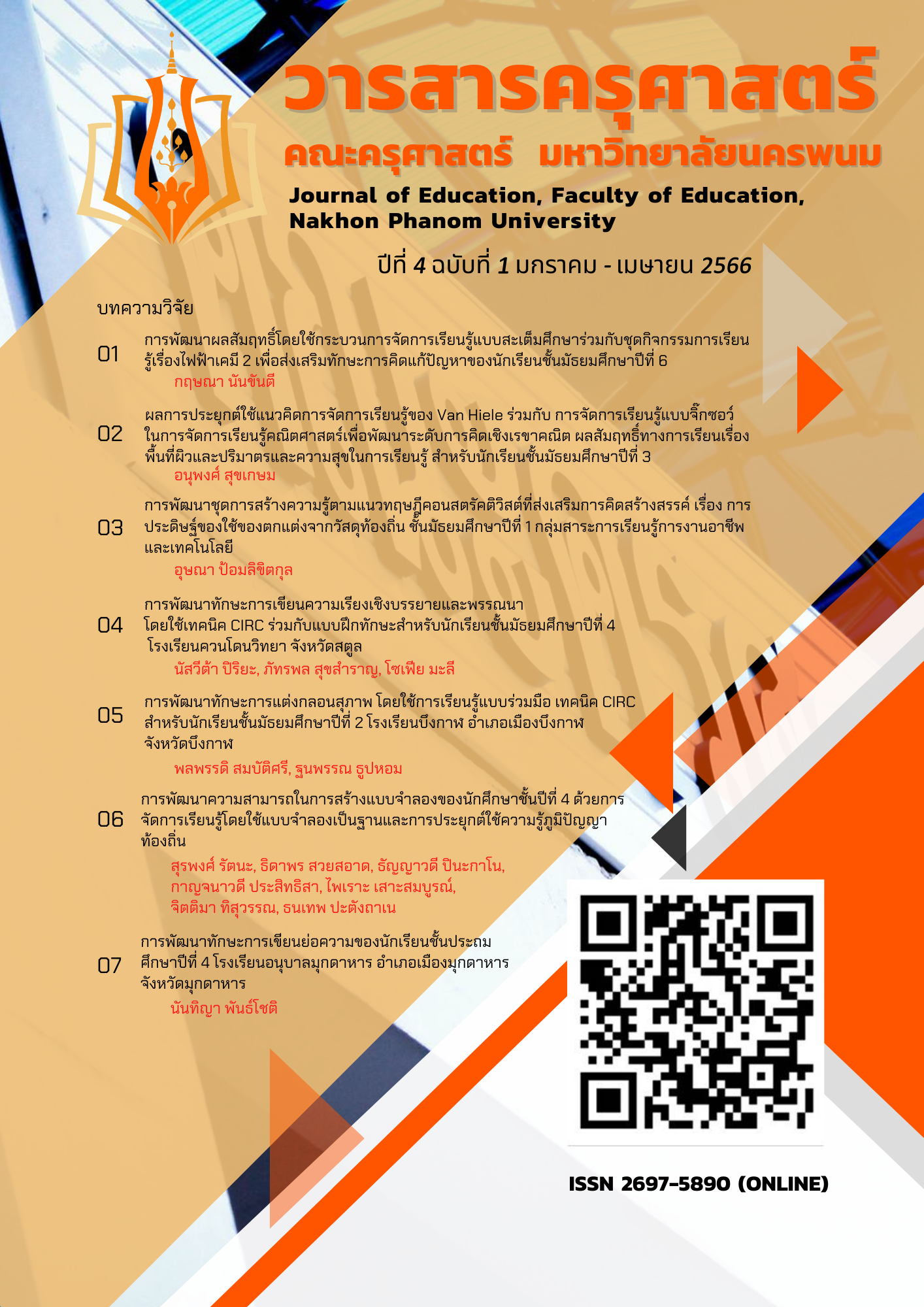The Effects of Using Van Hiele Model and Jigsaw Approach to Mathematics Learning to Develop Geometric Thinking Level, Mathematical Achievement Of Surface Area and Volume Chapter and Learning Happiness of Grade 9 Students
Main Article Content
Abstract
The study aimed to compare geometric thinking level, mathematical achievement and on a surface area and volume before and study learning happiness after learning for grade 9 students by using Van Hielie model combined with Jigsaw approach. The samples were 17 grade 9 students in the first semester academic year 2022. The tools were lesson plans, geometric thinking, mathematical achievement tests of a surface area and volume and learning happiness questionaries. Data was analyzed by arithmetic mean, standard deviation and statistical testing by sign test and Wilcoxon matched-pairs signed ranks test.
The result showed that: By applying Van Hielie model combined with Jigsaw approach for learning management, student’s posttest of geometric thinking level and mathematical achievement of a surface area and volume was higher than pretest at the .05 statistically significant. And student’s learning happiness was at a high level.
Article Details

This work is licensed under a Creative Commons Attribution-NonCommercial-NoDerivatives 4.0 International License.
บทความที่ได้รับการตีพิมพ์เป็นลิขสิทธิ์ของวารสารครุศาสตร์ คณะครุศาสตร์ มหาวิทยาลัยนครพนม ข้อความที่ปรากฏในบทความแต่ละเรื่องในวารสารครุศาสตร์เล่มนี้เป็นความคิดเห็นส่วนตัวของผู้เขียนแต่ละท่านไม่เกี่ยวข้องกับมหาวิทยาลัยนครพนม และคณาจารย์ท่านอื่น ๆ ในมหาวิทยาลัยฯ แต่อย่างใด ความรับผิดชอบองค์ประกอบทั้งหมดของบทความแต่ละเรื่องเป็นของผู้เขียนแต่ละท่าน หากมีความผิดพลาดใด ๆ ผู้เขียนแต่ละท่านจะรับผิดชอบบทความของตนเองแต่ผู้เดียว
References
บรรณานุกรม
จุฑาทิพย์ เต็มวิบูลย์โชค. (2560). กิจกรรมการเรียนการสอนคณิตศาสตร์โดยใช้เทคนิคจิ๊กซอว์ที่เสริมสร้างความสามารถในการแก้ปัญหาทางคณิตศาสตร์ เรื่อง การวัดค่ากลางของข้อมูล ของนักเรียนชั้นมัธยมศึกษาปีที่ 5. วารสารศึกษาศาสตร์. 28(1) : 110-123.
ชมนาด เชื้อสุวรรณทวี. (2561). การเรียนการสอนคณิตศาสตร์ Mathematics Instruction. กรุงเทพฯ : โรงพิมพ์แห่งจุฬาลงกรณ์มหาวิทยาลัย.
ชัชวิทย์ สงวนภักร์. (2557). การพัฒนาโปรแกรมเสริมสร้างสุขในการเรียนตามแนวคิดจิตตปัญญาศึกษาของนิสิตระดับปริญญาตรี ชั้นปีที่ 2 มหาวิทยาลัยเกษตรศาสตร์ วิทยาเขตบางเขน. ปริญญานิพนธ์ กศ.ม. (การวิจัยและพัฒนาศักยภาพมนุษย์). กรุงเทพฯ: บัณฑิตวิทยาลัย มหาวิทยาลัยศรีนครินทรวิโรฒ.
ณัชชา กมล. (2558). ตัวแบบของโซโล: กรอบแนวคิดในการวิเคราะห์การคิดเชิงคณิตศาสตร์. วารสารศรีนครินทรวิโรฒวิจัยและพัฒนา (สาขามนุษยศาสตร์และสังคมศาสตร์). 7(14) : 218-227.
ณัชฎาภา นิมตรดี และ นัฐจิรา บุศย์ดี. (2560). การจัดการเรียนรู้ตามแนวปฏิบัติสู่ผลสัมฤทธิ์ขั้นสูงเพื่อส่งเสริมการคิดเชิงเรขาคณิตของนักเรียนชั้นมัธยมศึกษาปีที่ 3. การประชุมประจำปีครั้งที่ 22 ในสาขาคณิตศาสตร์ จัดโดย ภาควิชาคณิตศาสตร์ คณะวิทยาศาสตร์ มหาวิทยาลัยเชียงใหม่.
รัชนี ทาเหล็ก. (2556). ผลการจัดการเรียนรู้แบบร่วมมือด้วยเทคนิคจิ๊กซอว์ เรื่อง เส้นขนาน ที่มีต่อความสามารถในการวิเคราะห์ของนักเรียนชั้นมัธยมศึกษาปีที่ 2. สารนิพนธ์ กศ.ม. (การมัธยมศึกษา). กรุงเทพฯ: บัณฑิตวิทยาลัย มหาวิทยาลัยศรีนครินทรวิโรฒ.
วิภาพร งอยกุดจิก และ หล้า ภวภูตานนท์. (2558). การพัฒนากิจกรรมการเรียนรู้คณิตศาสตร์ โดยใช้รูปแบบการสอนตามแนวคิดของ Van Hiele และใช้โปรแกรม The Geometer’s Sketchpad เป็นเครื่องมือช่วยการเรียนรู้เรื่อง ความสัมพันธ์ระหว่างรูปเรขาคณิตสองมิติและสามมิติ ชั้นมัธยมศึกษาปีที่ 1. วารสารศึกษาศาสตร์ มหาวิทยาลัยขอนแก่น. 38(2) : 96-102.
สำนักงานคณะกรรมการการศึกษาขั้นพื้นฐาน. (2560). ตัวชี้วัดและสาระการเรียนรู้แกนกลาง กลุ่มสาระการเรียนรู้คณิตศาสตร์ (ฉบับปรับปรุง พ.ศ. 2560) ตามหลักสูตรแกนกลางการศึกษาขั้นพื้นฐาน พุทธศักราช 2560. กรุงเทพฯ : สำนักคณะกรรมการการศึกษาขั้นพื้นฐาน กระทรวงศึกษาธิการ.
อลงกรณ์ ตั้งสงวนธรรม และคณะ. (2561). การใช้รูปแบบ Van Hiele ในการพัฒนาการเรียนการสอนการพิสูจน์ทางเรขาคณิต สำหรับนักเรียนชั้นมัธยมศึกษาปี ที่ 3. วิทยาสารเกษตรศาสตร์ สาขาสังคมศาสตร์. 39(2561) : 634-644.
อัมพร ม้าคนอง. (2553). ทักษะและกระบวนการทางคณิตศาสตร์ : การพัฒนาเพื่อพัฒนาการ. กรุงเทพฯ : ศูนย์ตำราและเอกสารทางวิชาการ คณะครุศาสตร์ จุฬาลงกรณ์มหาวิทยาลัย.
อัมพร ม้าคนอง. (2557). คณิตศาสตร์สำหรับครูมัธยม. กรุงเทพฯ : จุฬาลงกรณ์มหาวิทยาลัย.
อิทธิพัฒน์ สุวทันพรกูล. (2561). การวิจัยทางการศึกษา: แนวคิดและการประยุกต์ใช้. กรุงเทพฯ: โรงพิมพ์แห่งจุฬาลงกรณ์มหาวิทยาลัย.
Crowley, M. L. (1987). The van hiele model of the development of geometric thought. Teaching and Learning, K-12 – 1987 Yearbook. Virginia, USA: NCTM.
Olusegun, B, S. (2015). Constructivism Learning Theory: A Paradigm for Teaching and Learning. IOSR Journal of Research & Method in Education. 5(1) : 66-70.
Steinbrink, J, J. and Stahl, R, J. (1994). Jigsaw III = Jigsaw II + cooperative test review: Application to the social studies classroom. In cooperative learning in social studies: A handbook for teachers pp.131-152. California” Addison-Wesley publishing company.
Willson, J, W. (1971). Evaluation of Learning in Secondary School Mathematics: A Handbook on Formative and Summative Evaluation of Students Learning. New York: Mc Graw Hill.
Translate Thai Reference
Cheausuwantavee, C. (2018). Mathematics Instruction. Bangkok: Chulalongkorn University Printing House.
Kamol, N. (2015). SOLO model : A framework for analyzing mathematical thinking. Srinakharinwirot research and development (Journal of humanities and social sciences). 7(14) : 218-227.
Makanong, A. (2010). Skills and Mathematical Process. Developing for Development. Book and Academic Document Center of Faculty of Education, Chulalokorn University.
Makanong, A. (2014). Mathematics for Secondary School Teachers. Bangkok: Chulalongkorn University.
Ngoykudjik, V. and Pavaputanon, L. (2011). The Development of Mathematics Learning Activities Based on van Hieles’ Theory Utilizing The Geometer’s Sketchpad As A Learning Tool On Relation Between Two-Dimensional Geometric Figures and Three-Dimensional Geometric Figures for Matthayomsuksa 1. Journal of Education khon Kaen University. 38(2) : 96-102.
Nimitdee, N. and Busdee, N. (2017). Learning Management by using way to high achievement toward to geometric thinking for mathayomsuksa 3 students. The 22nd annual meeting in mathematics (AMM 2017) by Department of mathematics, Faculty of science Chiangmai University.
Office of the Basic Education Commission. (2017). Indicators and Core Content Mathematics Learning Area (Revied Edition B.E. 2560) According to The Basic Education Core Curriculum B.E. 2551. Office of the Basic Education Commission, Ministry of Education.
Snguanphak, C. (2014). The Development of program which enhances happiness in learning based on contemplative for sophomore students of Kasetsart university, Bankkhen campus. M.Ed. (Research and development on human potentials). Bangkok : Graduate school. Srinakharinwirot university.
Suwanthanpornkul, I. (2018). Educational research: Concept and application. Bangkok: Chulalongkorn University Printing House.
Temwiboolchok, C. (2017). Mathematical Instructional Activities Using Jigsaw Technique to Enhance Problem-Solving Abilities on Measure of Central Tendency for Mathayomsuksa Five Students. Journal of Education. 110-123.

